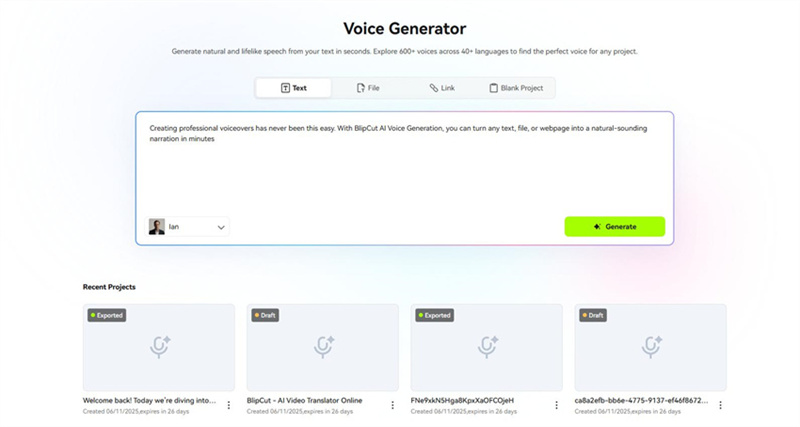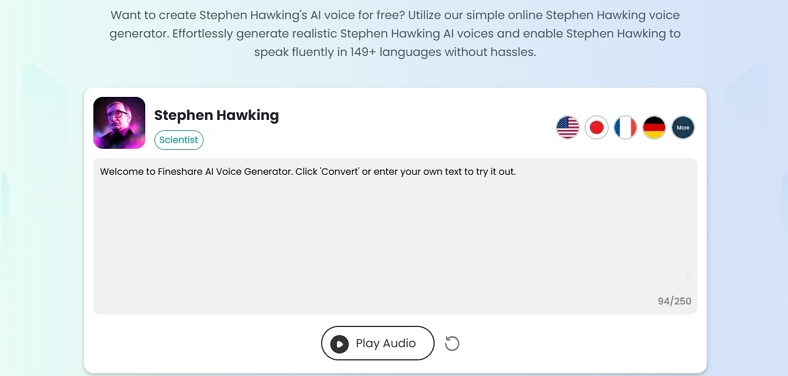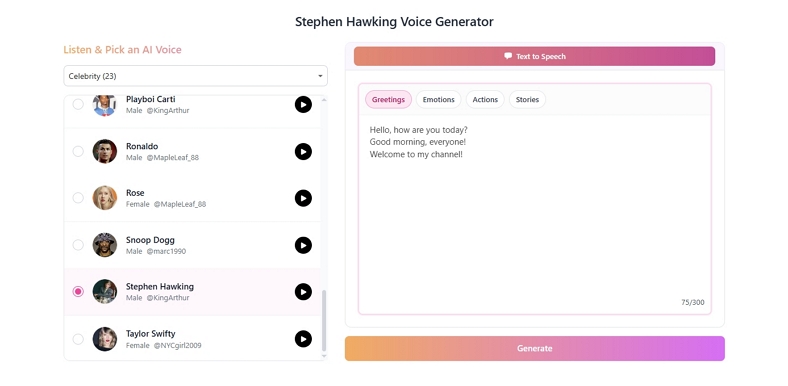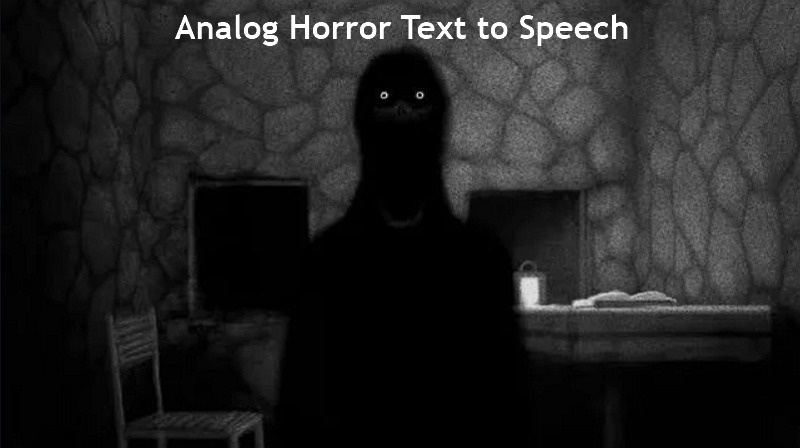Few voices in history are instantly recognized as they are heard. One of the most recognizable voices of all time is the mechanical voice of Stephen Hawking, generated through a computer system he used to communicate. While his voice is legendary and recreating it with the same tone and rhythm has always been a challenge.
Thanks to advanced AI technology that allows users to clone and recreate any iconic voice with accuracy and expressive details. In this article, we’ll explore the best options for a Stephen Hawking voice generator for mimicking the exact rhythm and tone of his mechanical voice.
Part 1. Why People Are Using a Stephen Hawking Voice Generator?
The rise of AI voice tools has made Stephen Hawking’s voice easier to access and recreate. Before exploring the top Stephen Hawking voice simulator options, let’s see who people use it.
1.Educational and Documentary Use: Teachers use Hawking-style voices to explain science topics in a way that feels authentic. The robotic tone adds depth to educational videos and helps the audience connect with complex ideas.
2.Entertainment and Parody: YouTube and TikTok creators use generated voice to make funny and nostalgic clips that stand out. The Stephen Hawking tone gives their content a familiar edge that instantly grabs attention.
3.Accessibility and Voice Identity: People with speech difficulties choose this voice to express themselves with confidence and independence. Using a Hawking-like voice helps them communicate clearly while feeling connected to his legacy.
4.Technology Demonstrations: Tech professionals use this voice to test new AI engines and show how synthetic speech has evolved over time. It highlights the progress from early mechanical systems to modern neural network voices.
5.Language Learning and Translation: Voice cloning tools now allow Hawking’s voice to read text in different languages with natural rhythm. This helps learners experience pronunciation and fluency through a voice they already recognize.
Part 2. Key Features to Look for in a Stephen Hawking Voice Generator Tool
After exploring the reason for using a Stephen Hawking computer voice generator, let’s look at the features that a voice simulator offers. Keep these features in mind before signing up for a tool.
1.Voice Cloning: Produces a distinct robotic sound for authentic speech output with every word spoken.
2.Speed Control: Lets you adjust audio speed for preferred pacing during live or pre-recorded voiceovers.
3.Multi-Language: Supports many languages and accents for accessibility and wider audience reach in projects.
4.Text-to-Speech (TTS): Converts written content into high-fidelity, synthesized audio with minimal effort or delay.
5.Privacy Protection: Protects user data while processing text and exporting generated voice audio files.
6.Pause Control: Allows precise pause timing for clarity in narration and improved understandability in presentations.
Part 3. 5 Best Stephen Hawking Voice Generator To Use Online
Now that you know what key features to look for before choosing a Stephen Hawking sound generator. Let’s explore the best tools you can try for text-to-AI voice generation.
1. BlipCut AI Voice Generator
This tool is one of the best options that help users turn simple text prompts into a mimicked voice. Users can type text or upload audio and video files to clone specific voices and produce realistic results in minutes. It helps users to break language barriers with a very user-friendly web interface.
Unlike other voice generation tools, it uses advanced AI models like ChatGPT and DeepSeek to generate a realistic voice that is difficult to catch. It also includes advanced features like speech rate adjustment and pronunciation to match the original tone.

Key Features
-
Users can mimic voices from social media platforms with just a link.
-
Transforms text-to-voice with more than 600 realistic AI voices instantly.
-
Let users adjust pitch, speed, and tone for tailored expression and style.
-
Generated Stephen Hawking’s voice in more than 40 languages and accents.
-
Exports generated output in multiple formats like MP3, SRT, and more.
2. Fineshare AI Voice Generator
This tool helps users convert text into speech with an ultra-realistic Stephen Hawking voice without requiring software installation. They can select the iconic Hawking voice, input their message, and get a generated voice in over 149 languages. It lets users create personalized messages, voiceovers for videos, and voices for games used worldwide.

Pros
![]()
-
Users can adjust the pitch and speed of the generated voice.
-
Transform your voice into multiple styles and characters in real-time.
Cons
![]()
-
Access to only 5 voices and 3 audio effects in basic version.
-
Lacks tool guides and tutorials on the platform.
3. AI Voice Lab
It is a Hawking voice generator that enables users to turn any text into ultra-realistic speech imitating Stephen Hawking’s iconic voice. AI Voice Lab simplifies the professional voice production for presentations, creative videos, or character dialogue without costly studios or hiring voice actors. Users can pick from a library of voices in many languages and generate voice-over for multiple uses.

Pros
![]()
-
Provides different accent options based on the situation of project.
-
Access to an extensive collection of voice options, including multiple character voices.
Cons
![]()
-
Lacks true human emotional depth in highly expressive contexts.
-
Not able to read certain words that are not normally used.
4. Galaxy.ai
This is a Stephen Hawking voice generator that helps users turn text into a robotic sound. Its AI model is trained to match the exact specifications of Hawking’s speech synthesis system. It helps people make learning videos and projects with machine speech and can also be used for science clips or creative experiments.

Pros
![]()
-
Allows accurate control over speech rate and pausing to replicate Hawking's style.
-
No login required for generating AI voices and customizations.
Cons
![]()
-
From 3000 diverse tools, finding the right one is likely impossible for beginners.
-
Voices can sound less natural in expressive tasks.
5. TopMediai
This Stephen Hawking voice generator website provides a robotic voice output that mimics his iconic tone. It supports multiple audio formats for export and provides adjustable pitch and speed for precise control. The platform also allows batch text-to-speech conversion and provides synthesized voice suitable for a variety of digital projects.

Pros
![]()
-
Provides a huge selection of over 3,200+ voices to choose from.
-
Users can adjust speed, volume, pitch, and emotion for personalized output.
Cons
![]()
-
Advanced AI technology requires powerful hardware to generate voice.
-
The platform offers limited integration options with other apps or software.
Comparison of Best Stephen Hawking Voice Generators
Now, we’ll compare all tools to help you decide which Stephen Hawking sound generator is best for your needs.
| Tools | Input Data Format | Customization | Input Size Limit | Batch File Processing | Export Formats |
|---|---|---|---|---|---|
| BlipCut AI Video Translator | Video (.mp4, .mov), Audio (.mp3) | Transcript & subtitle editing, speed, subtitle style | Unlimited file size and text | Video, Audio, SRT, VTT | |
| Fineshare AI Voice Generator | Text input | Pitch and speed control | 250 characters | N/A | MP3 |
| AI Voice Lab | Text input | Basic settings | 300 characters | N/A | Audio |
| Galaxy.ai | Text input, audio | Minor effects | 9999 characters | N/A | Audio, Video |
| TopMediai | Text input, MP3, WAV | Pitch, speed, volume, filters | 1000 characters | N/A | MP3, WAV |
Conclusion
To conclude, in this article, we explored the top options for a Stephen Hawking voice generator to mimic his iconic mechanical voice. We also compared these tools that can help you decide which tool is the best fit for your needs and creative projects. If you’re going to opt for a tool with an extensive voice library, we recommend using BlipCut AI Voice Generator.
Frequently Asked Questions
Q1. What AI voice did Stephen Hawking use?
A1: Stephen Hawking used the Speech Plus CallText 5010 synthesizer, featuring the “Perfect Paul” voice from DECtalk. This voice was based on KlattTalk technology that was developed by MIT scientist Dennis Klatt in the 1980s.
Q2. What app did Stephen Hawking use to talk?
A2: Stephen Hawking used a computer-based communication system running Assistive Context-Aware Toolkit (ACAT) software. The system included EZ Keys that let him select words spoken by the DECtalk speech synthesizer.
Q3. Is there a way to generate Stephen Hawking's voice in another language?
A3: The internet offers many Stephen Hawking speech generator tools for other languages to make realistic dubbing simple. BlipCut AI Voice Generator stands out for its over 40 language support, plus an extensive voice library and advanced speech rate control.
Leave a Comment
Create your review for BlipCut articles





Blake Keeley
Editor-in-Chief at BlipCut with over three years of experience, focused on new trends and AI features to keep content fresh and engaging.
(Click to rate this post)